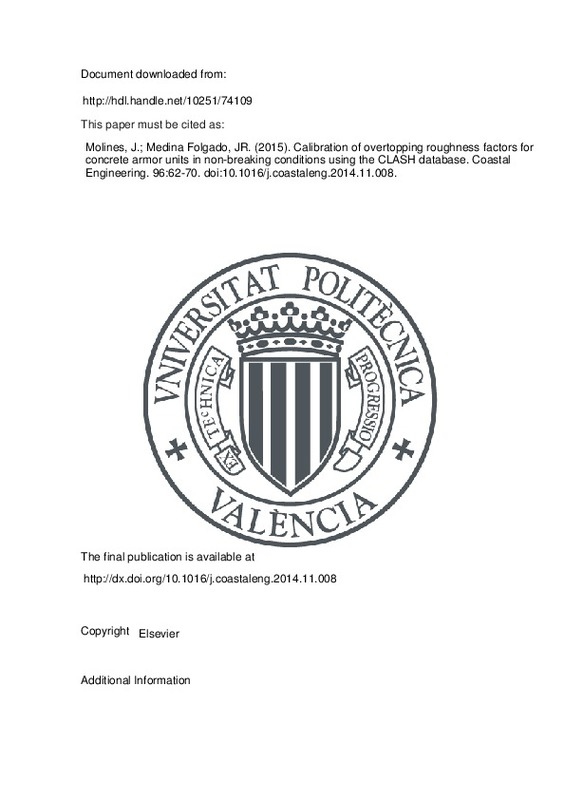JavaScript is disabled for your browser. Some features of this site may not work without it.
Buscar en RiuNet
Listar
Mi cuenta
Estadísticas
Ayuda RiuNet
Admin. UPV
Calibration of overtopping roughness factors for concrete armor units in non-breaking conditions using the CLASH database
Mostrar el registro sencillo del ítem
Ficheros en el ítem
| dc.contributor.author | Molines, Jorge
|
es_ES |
| dc.contributor.author | Medina Folgado, Josep Ramon
|
es_ES |
| dc.date.accessioned | 2016-11-15T18:43:50Z | |
| dc.date.available | 2016-11-15T18:43:50Z | |
| dc.date.issued | 2015 | |
| dc.identifier.issn | 0378-3839 | |
| dc.identifier.uri | http://hdl.handle.net/10251/74109 | |
| dc.description.abstract | The roughness factor (γf) is a parameter used in overtopping estimators to account for the effects of armor unit geometry, the number of layers in the armor and other structural characteristics. Different values of γf for the same armors are given in the literature; however, in this study, the value of γf was calibrated for each overtopping estimator using the best available overtopping data. A methodology based on a bootstrapping technique is proposed to statistically characterize the roughness factors which best fit each formula. For each selected armor unit and overtopping formula, three percentiles (10%, 50% and 90%) of γf are given. Five sets of γf are given for five different overtopping estimators, calibrated using overtopping data from the CLASH database and additional tests with Cubipod armors in non-breaking conditions. The results indicate differences up to 20% in the optimum values of γf compared to those given in the literature. Optimum roughness factors are provided for the CLASH neural network (CLNN); the CLNN was found to be a better overtopping estimator than the other four overtopping formulas compared in this study. The γf is dependent on both the overtopping estimator and the dataset used. Armor porosity affects not only armor roughness and overtopping but also armor hydraulic stability; thus, recommended packing densities must be followed to avoid changes in porosity during lifetime. The sensitivity of the overtopping prediction to the roughness factor depends on the relative crest freeboard (Rc/Hm0); the greater the Rc/Hm0, the higher the sensitivity. | es_ES |
| dc.description.sponsorship | The authors are grateful for financial support from Spanish Ministerio de Economia y Competitividad (Grant BIA2012-33967). The first author was funded through the FPU program (Formacion del Profesorado Universitario, Grant AP2010-4366) by the Spanish Ministerio de Educacion, Cultura y Deporte. The authors also thank Debra Westall for revising the manuscript. | en_EN |
| dc.language | Inglés | es_ES |
| dc.publisher | Elsevier | es_ES |
| dc.relation.ispartof | Coastal Engineering | es_ES |
| dc.rights | Reserva de todos los derechos | es_ES |
| dc.subject | Armor roughness | es_ES |
| dc.subject | Roughness factor | es_ES |
| dc.subject | Wave overtopping | es_ES |
| dc.subject | Mound breakwater | es_ES |
| dc.subject | Neural network | es_ES |
| dc.subject | CLASH database | es_ES |
| dc.subject | Crown wall | es_ES |
| dc.subject | EurOtop | es_ES |
| dc.subject.classification | INGENIERIA E INFRAESTRUCTURA DE LOS TRANSPORTES | es_ES |
| dc.title | Calibration of overtopping roughness factors for concrete armor units in non-breaking conditions using the CLASH database | es_ES |
| dc.type | Artículo | es_ES |
| dc.identifier.doi | 10.1016/j.coastaleng.2014.11.008 | |
| dc.relation.projectID | info:eu-repo/grantAgreement/MINECO//BIA2012-33967/ES/ESTABILIDAD HIDRAULICA DE LOS MANTOS DE ESCOLLERA, CUBOS Y CUBIPODOS FRENTE A OLEAJE LIMITADO POR EL FONDO/ | es_ES |
| dc.relation.projectID | info:eu-repo/grantAgreement/ME//AP2010-4366/ES/AP2010-4366/ | es_ES |
| dc.rights.accessRights | Abierto | es_ES |
| dc.contributor.affiliation | Universitat Politècnica de València. Departamento de Ingeniería e Infraestructura de los Transportes - Departament d'Enginyeria i Infraestructura dels Transports | es_ES |
| dc.contributor.affiliation | Universitat Politècnica de València. Escuela Técnica Superior de Ingenieros de Caminos, Canales y Puertos - Escola Tècnica Superior d'Enginyers de Camins, Canals i Ports | es_ES |
| dc.description.bibliographicCitation | Molines, J.; Medina Folgado, JR. (2015). Calibration of overtopping roughness factors for concrete armor units in non-breaking conditions using the CLASH database. Coastal Engineering. 96:62-70. https://doi.org/10.1016/j.coastaleng.2014.11.008 | es_ES |
| dc.description.accrualMethod | S | es_ES |
| dc.relation.publisherversion | http://dx.doi.org/10.1016/j.coastaleng.2014.11.008 | es_ES |
| dc.description.upvformatpinicio | 62 | es_ES |
| dc.description.upvformatpfin | 70 | es_ES |
| dc.type.version | info:eu-repo/semantics/publishedVersion | es_ES |
| dc.description.volume | 96 | es_ES |
| dc.relation.senia | 277471 | es_ES |
| dc.contributor.funder | Ministerio de Educación | es_ES |
| dc.contributor.funder | Ministerio de Economía y Competitividad | es_ES |







![[Cerrado]](/themes/UPV/images/candado.png)

